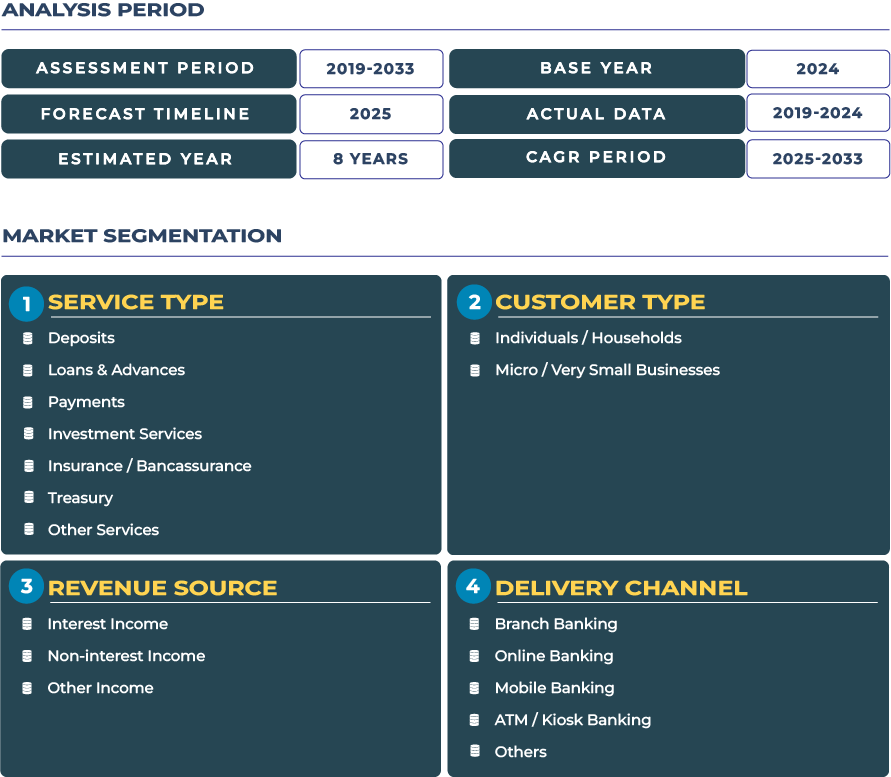Mobile Payment & Cross-Border Innovation: Spain Retail Banking Market Rewires Itself
Spain is rapidly repositioning its retail banking landscape around mobile payment ubiquity, instant transfers, and cross-border payment interoperability. The rise of platforms like Bizum-a mobile instant-payment system backed by a consortium of Spanish banks-is a linchpin in this transformation. Bizum already handles a large volume of P2P and merchant payments and is integrating with Portuguese and Italian systems under a European Payments Alliance. At the same time, incumbent banks such as CaixaBank are forging partnerships with Apple to enable split-payment features and expanded mobile card activation. These moves reflect Spain ambition to catalyze digital financial flows not just domestically but across borders.
Note:* The market size refers to the total revenue generated by banks through interest income, non-interest income, and other ancillary sources.
Market Outlook: Strategic Growth Pathways in Spain Banking Renovation
From 2025 to 2033, Spain retail banking market is forecast to expand from USD 55.5 billion to USD 69.9 billion, delivering a CAGR of 2.9%. The core banking lines-checking accounts, consumer credit, mortgages-remain central to volume, yet incremental value will increasingly derive from digital service monetization: transaction fees, micro-lending, insurance embedded in spending journeys, and cross-product bundling. Spain geographic positioning, EU membership, and evolving digital infrastructure poise it as a hub for cross-border financial flows within the Iberian and broader European context. However, macroeconomic headwinds-such as domestic unemployment pressures, inflation, and external shocks-may compress credit demand and tighten risk tolerance. Success will depend on banks’ ability to scale digital services, optimize cost structures, and orchestrate consumer journeys across borders and product lines.
Drivers & Restraints: Forces Shaping Spain Retail Banking Trajectory
Driving Momentum: Digital Literacy, Mobile Penetration & Payment Innovation
One significant growth driver is high internet penetration and rising digital literacy across Spain population, which substantially lowers customer acquisition friction for mobile banking. Over 80% of Spaniards use smartphones, enabling adoption of banking apps and mobile payments. The expansive reach of digital wallets such as Apple Pay, Google Pay, and PayPal complements local payment rails. Furthermore, Spanish banks have embraced instant transfer infrastructure: in 2024, instant payments constituted over half of P2P transfers, and regulatory enforcement (EU Regulation 2024/886) mandates instant transfers on par with standard ones. The combination of digital readiness, payment infrastructure, and regulation creates a favorable environment for mobile-centric retail banking models.
Constraining Factors: Unemployment, Compliance Costs & Credit Risk Sensitivity
Nevertheless, key constraints persist. Spain relatively high and volatile unemployment rate restricts consumer borrowing for retail credit, dampening demand for loans and impairing loan servicing. Regulatory compliance costs-particularly around AML, KYC, data protection, and PSD2 obligations-are significant for banks expanding digital products. Technical friction remains too: according to the Banco de España, card payments still dominate online transaction value, while e-payment solutions and mobile methods make up ~26%. This indicates persistence of legacy behaviors. Moreover, the reliance on regional branch networks and rural coverage imposes cost overhead, which is harder to rationalize in low-traffic areas. Any strategic shift must balance innovation with inclusion and infrastructure constraints.
Trends & Opportunities: Evolutionary Patterns in Spain Retail Banking Sector
Trend: Mobile Wallet Adoption & Rise of Digital Lending Platforms
One dominant trend is accelerating adoption of mobile wallets and integrated payments in everyday life. Platforms like Bizum are deeply embedded in Spanish banks and are increasingly used for e-commerce and offline payments. The “Buy Now, Pay Later” (BNPL) segment is also gaining traction, bridging retail purchases to flexible credit. In 2024 alone, Spain recorded notable BNPL expansion in e-commerce contexts. Meanwhile, digital lending platforms-often backed by fintech -are gaining share in consumer and micro-credit segments, layering agility over traditional underwriting. These developments reflect a shift toward on-demand, consumption-based credit models woven into daily spending behavior.
Opportunity: Cross-Border Mobile Payment Solutions & AI Credit Tools Expansion
A major growth opportunity lies in cross-border mobile payment interoperability. Bizum’s alliance with Portuguese and Italian systems (EuropPA) enables users across Spain, Portugal, and Italy to transact seamlessly-opening the door for cross-market retail banking journeys. Banks that support cross-market wallets, multi-currency settlement, and unified mobile interfaces will access new revenue pools. Another opportunity is implementing AI-based credit scoring and predictive risk models in consumer and small business segments. Real-time behavioral signals, open banking data, and transaction analytics can support micro-lending decisions and dynamic pricing. If deployed carefully with explainability, these tools could reduce default rates and improve underwriting ROI. Spain banks have a chance to leapfrog traditional credit models by integrating such AI into their apps and payments flows.
Competitive Landscape: Strategic Dynamics in Spanish Retail Banking
Spain retail banking market features prominent institutions such as Banco Santander, BBVA, CaixaBank, Banco Sabadell, and Unicaja. Banco Santander recently appointed a digital banking specialist to lead its Spain operations, underscoring its push to accelerate digital transformation. CaixaBank has cemented a leadership position in mobile payments, with over 4.4 million cards linked to mobile devices and more than 800 million transactions in the prior 12 months. Unicaja, a major Spanish savings bank, also continues consolidating presence through acquisitions and digital transformation. Fintech challengers like Bnext operate with digital-first models targeting younger segments, for example offering non-bank accounts and embedded services. The competition now centers less on branch density and more on mobile capabilities, data utilization, platform monetization, and cross-market partnerships.







